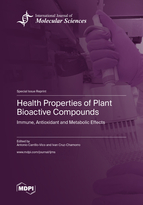Health Properties of Plant Bioactive Compounds: Immune, Antioxidant and Metabolic Effects
A special issue of International Journal of Molecular Sciences (ISSN 1422-0067). This special issue belongs to the section "Bioactives and Nutraceuticals".
Deadline for manuscript submissions: closed (31 July 2022) | Viewed by 47046
Special Issue Editors
2. Department of Medical Biochemistry and Molecular Biology, University of Seville, 41013 Sevilla, Spain
Interests: bioactive compounds; immunomodulation; oxidative stress; melatonin; multiple sclerosis
Special Issues, Collections and Topics in MDPI journals
Interests: functional foods; protein hydrolysate; antioxidant; immunomodulation; natural extracts; biopeptides; lupine; hemp
Special Issues, Collections and Topics in MDPI journals
Special Issue Information
Dear Colleagues,
Over the last two decades, plant bioactive compounds have been reported to confer beneficial health effects, such as antioxidant, anti-inflammatory, anti-cancer, anti-hypertensive, hypoglycemic, lipid-lowering, and metabolic effects, among others.
All these effects were described from in vitro and in vivo studies in which different plant-derived compounds, including proteins, protein hydrolysates, specific peptides, polyphenols, oils, juices, flowers, seeds, etc., were used.
Currently, there is a big increase in modern society lifestyle-related diseases, which are characterized by the loss of the control of the antioxidant and immune systems, as well as metabolic processes. Thus, plant bioactive compounds able to modify or to control these factors could be suitable candidate to develop plant-based functional food in health promotion.
It is also noteworthy the increasing attention to the environmental impact of the modern animal agriculture. Thus, the identification bioactive compounds from natural vegetable sources is an interesting strategy not only for replacing animal proteins with plant proteins, which is a central issue for health, but also for reducing the environmental impact of animal agriculture.
Therefore, this Special Issue of International Journal of Molecular Sciences, entitled “Health Properties of Plant Bioactive Compounds: Immune, Antioxidant and Metabolic Effects”, welcomes the submission of original articles or reviews that can improve the knowledge about the beneficial health effects of vegetable compounds, such as immunomodulation, antioxidant, and metabolic regulation.
Prof. Dr. Antonio Carrillo Vico
Dr. Ivan Cruz-Chamorro
Guest Editors
Manuscript Submission Information
Manuscripts should be submitted online at www.mdpi.com by registering and logging in to this website. Once you are registered, click here to go to the submission form. Manuscripts can be submitted until the deadline. All submissions that pass pre-check are peer-reviewed. Accepted papers will be published continuously in the journal (as soon as accepted) and will be listed together on the special issue website. Research articles, review articles as well as short communications are invited. For planned papers, a title and short abstract (about 100 words) can be sent to the Editorial Office for announcement on this website.
Submitted manuscripts should not have been published previously, nor be under consideration for publication elsewhere (except conference proceedings papers). All manuscripts are thoroughly refereed through a single-blind peer-review process. A guide for authors and other relevant information for submission of manuscripts is available on the Instructions for Authors page. International Journal of Molecular Sciences is an international peer-reviewed open access semimonthly journal published by MDPI.
Please visit the Instructions for Authors page before submitting a manuscript. There is an Article Processing Charge (APC) for publication in this open access journal. For details about the APC please see here. Submitted papers should be well formatted and use good English. Authors may use MDPI's English editing service prior to publication or during author revisions.
Keywords
- Oxidative stress
- Inflammation
- Metabolism
- Plant Bioactive compounds
- Functional food
- Nutraceuticals
- Natural extracts
- Human health
- Nutrition
- Metabolic syndrome
- Chronic diseases
- Cardiovascular diseases
- Cancer








